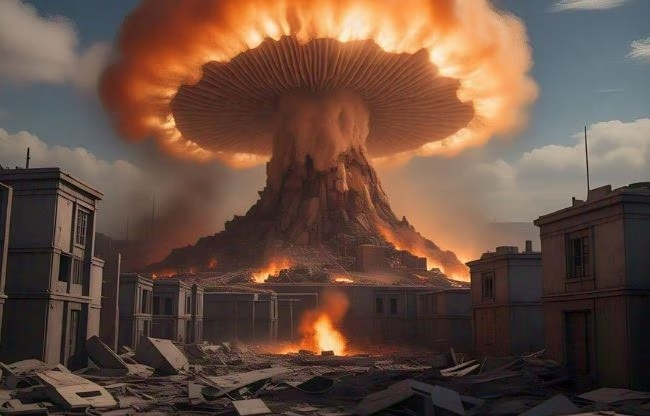The ominous specter of nuclear warfare looms again over the world, fueled by President Vladimir Putin of Russia approving updated nuclear weapons usage policies. Countries participating in aggression alongside a nuclear power may now be seen as hostile forces, potentially justifying nuclear retaliation.
This development follows President Biden's approval for Ukraine to employ American missiles against Russian targets, which heightened Russian hostilities. The Kremlin views this as provocation and warns western nations: if weapons are used within Russian territory, targets will broaden beyond Ukraine to the countries involved.
Following Putin's decision to exit last year’s non-nuclear proliferation pact, giving rise to nuclear confrontation discussions, the situation remains tense. With nuclear escalation on the horizon, global concerns about the potential of World War III amplify.
The new nuclear stance suggests that assaults with NATO nation missiles might trigger Russian nuclear responses. Nonetheless, Foreign Minister Sergei Lavrov assures that Russia will attempt to avert nuclear conflict.
1.
If a missile attack on Russia is supported by a nuclear state, a nuclear response is possible.
2.
Unmanned aerial strikes could similarly warrant nuclear retaliation.
3.
Ballistic missile threats towards Russia might provoke a nuclear counter.
4.
Perceived aerial offensives could equate to acts of war, potentially justifying nuclear defense.
5.
Greater threats to Russian territories might prompt deployment of nuclear missiles and defense systems for protection.
From the conflict's inception, there's been potential for nuclear confrontation. February 2022 saw Putin issue dire warnings to external influencers, interpreted as nuclear references.
Emphasizing Russia's resolute defense, CIA chief Burns cautioned careful evaluation of Putin’s assertions, underlining significant global stakes.
Subsequent to nuclear policy advancements, palpable unease permeates NATO nations. Alerts have emanated globally, with Norway instructing citizens on wartime readiness. Guidelines emanated from Sweden on preparedness, complemented by iodine suggestions for radiation avoidance, and Finland urges power backup due to potential disruptions.

Source: aajtak
A nuclear engagement is an unthinkable horror, now only speculated upon, reminiscent of past events. Survivors of Japan’s historical nuclear attacks recall siege days borne of devastation, signifying nuclear war's destructive legacies.
The International Campaign to Abolish Nuclear Weapons (ICAN), a Nobel-winning entity, predicts a single nuclear blast ensnaring countless lives. If numerous bombs are deployed, the death toll and global climate would catastrophically unravel.
ICAN outlines widespread fatalities arising from extensive nuclear arsenals. A hypothetical US-Russia nuclear exchange could skyrocket casualties to over a hundred million, highlighting the gravity of present tensions.
Consider Mumbai: densely populated and vulnerable. An event paralleling Hiroshima’s devastation could result in immense casualties—within days, lives lost cresting hundreds of thousands. Warfare involving substantial warheads would enact unfathomable human mortality.
A Hiroshima-magnitude detonation replicated multiple times would unhinge Earth’s order. Ensuing environmental upheaval would markedly impair agriculture.
Already battling climate challenges, a nuclear conflict would steep the Earth in abrupt cooling, provoking unyielding darkness. Predictably, vast swathes would remain sunless, devastating natural ecosystems.
Widespread nuclear weapons use would inject astronomical smoke into the stratosphere, encroaching upon crucial layers like the ozone, with dire consequences.

Source: aajtak
World War II compelled drastic measures against Japan, with Hiroshima and Nagasaki enduring unprecedented nuclear bombings in August 1945.
Hiroshima saw nearly 140,000 fatal casualties before 1945's close. Subsequently, Nagasaki's devastation, although geographically contained by its mountains, resulted in tens of thousands deceased from lingering radiations.
Nuclear strikes deliver swift ruin within seconds, yet enduring legacies unspool across decades. Survivors faced ailments like leukemia and cancers, and countless impacts on sight and vitality were witnessed.
ICAN reports reveal over 12,000 nuclear weapons under the control of nine global powers. This includes arsenals from Russia, the US, China, France, the UK, Pakistan, India, Israel, and North Korea.
Russia leads with 5,889 nuclear weapons, followed by the US maintaining 5,224. American weapons are positioned across partner territories in Italy, Turkey, Belgium, Germany, and the Netherlands.
Equipment counts include China's 410, France’s 290, the UK's 225, Pakistan’s 170, India's 164, Israel’s 90, and North Korea’s 30 devices. Notably, Israel retains reserve capacity to considerably expand its arsenal.




